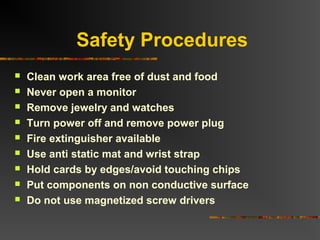Assembling a computer
- 1. Presentation on Assembling a Computer Presenting By: Neeraj Dhiman
- 2. Safety Procedures Clean work area free of dust and food Never open a monitor Remove jewelry and watches Turn power off and remove power plug Fire extinguisher available Use anti static mat and wrist strap Hold cards by edges/avoid touching chips Put components on non conductive surface Do not use magnetized screw drivers
- 3. Electrostatic Discharge If you notice it, it’s at least 2000 volts Charge of 200 volts can damage components Keep all components in anti-static bags Humidity above 50% Use grounded mats (workbench and floor) Use wrist straps Periodically touch unpainted grounded metal computer parts to lower the body’s static energy
- 4. Keeping an Inventory Document all components, parts purchased Use an inventory checklist May be difficult to recall later Will be helpful in locating and downloading device drivers Note specific warranty info Save specifics about installation and maintenance requirements so warranties will be valid Use small box to hold all manuals and disks Label box for specific computer Store in secure place
- 5. Choosing a computer case and system unit Case Allows easy access to internal components Provides room for expansion ATX form factor Available desk top space LED indicators on front Dust filters if area where computer to be used is dusty Power supply Minimum 250 watts ATX Single 20 pin Fan pulls air through case from front to back
- 6. Preparing to install Motherboard Review the motherboard location map Configure the motherboard Install the CPU, heat sink and fan, RAM Connect power supply cables to motherboard power connectors and misc. connectors to correct switches and lights Set the system BIOS
- 7. Configuring the processor Set jumper settings for appropriate frequency Ensure the CPU used supports the BUS speed and the CPU clock speed of Motherboard
- 8. Installing the CPU ZIF (Zero Insertion Force) trait on nearly all socket 7 and similar types Inspect pins for damage Locate pin 1 on both chip and socket Open the ZIF socket (raise lever) Insert processor (should easily slide on) Make sure there is not a gap between bottom of chip and socket Push lever down Set CPU voltage jumper settings if necessary (Pentium II and later CPU’s adjust automatically to voltage)
- 9. Install Heat Sink and Fan Attach fan to heat sink if not already attached Apply thin layer of compound to chip surface Attach heat sink by placing squarely on top of processor and press down gently Bend clips in place to hold sink Make sure there is good contact between sink and Chip surface Wipe off any excess compound Plug power cord from fan to fan power pins on motherboard
- 10. Install RAM Two types RAM used on most PC’s DDR1 DDR2 Look at motherboard map to determine which bank to place DIMM 1 module in Orient the Dimm chip over the slot (keyed) and insert into slot Lock in place by closing levers
- 11. Installing the Motherboard Position case for easy access, locate holes on motherboard and corresponding holes on case Insert spacers that came with motherboard into holes on case and install plastic standoffs into holes on motherboard Carefully slide the board into the case, lining up holes Tighten board to case with screws Verify that the back of the motherboard is not touching the case, all slots and connectors line up properly, board is securely held in place, and board does not bend when pressed
- 12. Attaching LEDs, key lock and speaker Use motherboard manual as a guide for proper placement Turbo LED (mainly legacy item) Power LED Hard drive activity LED Key lock switch (common with older systems, rare now; prevented BIOS meddling) PC speaker
- 13. Connect power supply cables AT motherboard Locate two large wire leads from power supply (P8 and P9) Locate 12 pin power connector on motherboard Plug P8 and P9 into connector Be sure black wires are in the middle beside one another ATX motherboard Attach the connector that is keyed to fit only one way into the motherboard connector
- 14. Attach hard drive and CD-ROM Use separate IDE cables if possible and set both jumpers to Master (or single on the hard drive if available) If sharing an IDE cable, set the hard drive to Master and the CD- ROM to slave Install hard drive away from power supply which can act like a magnet and destroy data Keep hard drive near front of case to benefit from air drawn into case and keep away from other hardware Slide drive into selected drive rail and screw drive into place Attach ribbon cable to the primary controller of the motherboard and attach power cord Follow with CD-ROM installation and attach to secondary controller of the motherboard
- 15. Installing a video card Use AGP expansion slot if available, otherwise use PCI or ISA Remove slot insert and insert video card by aligning pins and gently applying pressure Secure to case with a screw Some motherboards have built-in video. If you want to install an external card then you must disable the built in video in the CMOS AGP VIDEO CARD
- 16. Post Assembly Checklist All expansion cards are fully inserted CPU fan is attached to power The 110/220 volt switch is configured properly Drives are connected to power Ribbon cables are attached correctly Fans are free from interference from wires CPU voltage settings are correctly configured Power switch is off and power supply connectors are connected properly to motherboard All connections are tight Pins are properly aligned Close the case before booting Connect keyboard, mouse and monitor and plug in AC power
- 17. We've successfully assembled a computer THANK YOU ANY QUERY

















